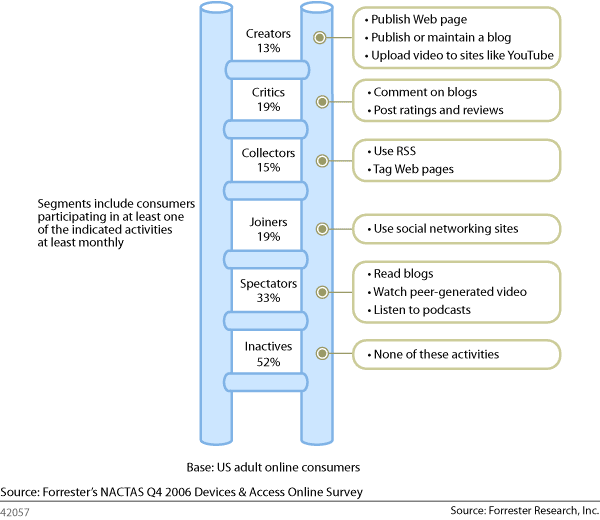Two publications recently came out which try to break out of the “everyone uses Web 2.0” versus “no one uses Web 2.0” argument and produce more detailed breakdowns of different kinds of people and different ways of using different web 2.0 technologies.
The first (as described on Charlene Li’s blog) is Forrester’s Social Technographics report:
At the heart of Social Technographics is consumer data that looks at how consumers approach social technologies – not just the adoption of individual technologies. We group consumers into six different categories of participation – and participation at one level may or may not overlap with participation at other levels. We use the metaphor of a ladder to show this, with the rungs at the higher end of the ladder indicating a higher level of participation.
The second, more recent report is from the PEW Internet & American Life foundation: “A Typology of Information and Communication Technology Users.”
They break down the participants into three major categories:
- Elite Tech Users (31% of American adults)
- Middle-of-the-road Tech Users (20%)
- Few Tech Assets
Each of those areas has subsegments as well – for example, the Elite Tech Users are divided into Omnivores (8%), Connectors (7%), Lackluster Veterans (8%), and Productivity Enhancers (8%).
The PEW report I think is ultimately the more valuable of the two – the Forrester “ladder” metaphor helps to explain the basic concept that you shouldn’t think of either your audience or “social media” as monolithic ideas: different audience profiles can and should lead to different priorities in terms of site design and development – but I find the overlap between the different rungs of the ladder confusing at best and misleading if not read carefully.

The PEW report comes with lengthy appendices with all the raw data, as well as clear delineation between the different groups while still recognizing how different behaviors and attitudes are shared across segments.
It’s also available free of charge, unlike the Forrester report.